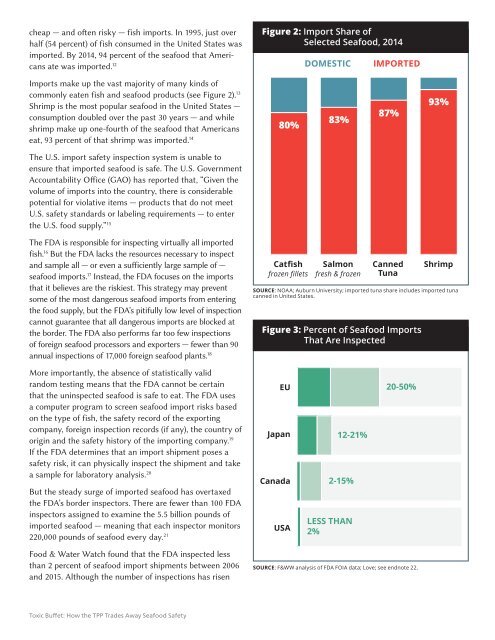TOXIC BUFFET
rpt_1609_tpp-fish-web
rpt_1609_tpp-fish-web
Create successful ePaper yourself
Turn your PDF publications into a flip-book with our unique Google optimized e-Paper software.
cheap — and often risky — fish imports. In 1995, just over<br />
half (54 percent) of fish consumed in the United States was<br />
imported. By 2014, 94 percent of the seafood that Americans<br />
ate was imported. 12<br />
Figure 2: Import Share of<br />
Selected Seafood, 2014<br />
DOMESTIC<br />
IMPORTED<br />
Imports make up the vast majority of many kinds of<br />
commonly eaten fish and seafood products (see Figure 2). 13<br />
Shrimp is the most popular seafood in the United States —<br />
consumption doubled over the past 30 years — and while<br />
shrimp make up one-fourth of the seafood that Americans<br />
eat, 93 percent of that shrimp was imported. 14<br />
80%<br />
83%<br />
87%<br />
93%<br />
The U.S. import safety inspection system is unable to<br />
ensure that imported seafood is safe. The U.S. Government<br />
Accountability Office (GAO) has reported that, “Given the<br />
volume of imports into the country, there is considerable<br />
potential for violative items — products that do not meet<br />
U.S. safety standards or labeling requirements — to enter<br />
the U.S. food supply.” 15<br />
The FDA is responsible for inspecting virtually all imported<br />
fish. 16 But the FDA lacks the resources necessary to inspect<br />
and sample all — or even a sufficiently large sample of —<br />
seafood imports. 17 Instead, the FDA focuses on the imports<br />
that it believes are the riskiest. This strategy may prevent<br />
some of the most dangerous seafood imports from entering<br />
the food supply, but the FDA’s pitifully low level of inspection<br />
cannot guarantee that all dangerous imports are blocked at<br />
the border. The FDA also performs far too few inspections<br />
of foreign seafood processors and exporters — fewer than 90<br />
annual inspections of 17,000 foreign seafood plants. 18<br />
<br />
<br />
Salmon<br />
<br />
Canned<br />
Tuna<br />
SOURCE: NOAA; Auburn University; imported tuna share includes imported tuna<br />
canned in United States.<br />
Figure 3: Percent of Seafood Imports<br />
That Are Inspected<br />
<br />
More importantly, the absence of statistically valid<br />
random testing means that the FDA cannot be certain<br />
that the uninspected seafood is safe to eat. The FDA uses<br />
a computer program to screen seafood import risks based<br />
on the type of fish, the safety record of the exporting<br />
company, foreign inspection records (if any), the country of<br />
origin and the safety history of the importing company. 19<br />
If the FDA determines that an import shipment poses a<br />
safety risk, it can physically inspect the shipment and take<br />
a sample for laboratory analysis. 20<br />
But the steady surge of imported seafood has overtaxed<br />
the FDA’s border inspectors. There are fewer than 100 FDA<br />
inspectors assigned to examine the 5.5 billion pounds of<br />
imported seafood — meaning that each inspector monitors<br />
220,000 pounds of seafood every day. 21<br />
EU<br />
Japan<br />
Canada<br />
USA<br />
12-21%<br />
2-15%<br />
LESS THAN<br />
2%<br />
20-50%<br />
Food & Water Watch found that the FDA inspected less<br />
than 2 percent of seafood import shipments between 2006<br />
and 2015. Although the number of inspections has risen<br />
SOURCE: F&WW analysis of FDA FOIA data; Love; see endnote 22.<br />
Toxic Buffet: How the TPP Trades Away Seafood Safety


